Part 5 – The People
I have never really seen the appeal of disaster tourism. If I have ever had any desire to visit a place after a disaster, it has been to help, not to watch. Granted, I understand that tourist dollars are one of the better ways to help an area bounce back, but based on some other tours I have heard about and seen advertised over the years (particularly some in New Orleans’ Ninth Ward in the wake of Hurricane Katrina), I get the impression that they usually lean more to the side of voyeurism than progressive assistance.
In the early days after the disaster, at least one person snuck into the Exclusion Zone to take pictures of abandoned homes. There was international outrage, but especially from the Japanese who found it incredibly disrespectful. Because of that, I had some reservations about going on this tour. I didn’t want anyone to think that I was there to gawk at them and feel fortunate that it was them, not me.
I probably would not have paid to join any Exclusion Zone tour because of my fear of misunderstood intentions. However, the fact that I was being asked to share the stories of the people we met made it feel more positive and productive than a standard arrangement. Overall, I felt that Japan Wonder Travel[1] was very respectful in its approach. It was informative, and although we did see some destroyed houses, we walked past them from the street. We were not watching from bus windows as people picked up the shattered remains of their lives.
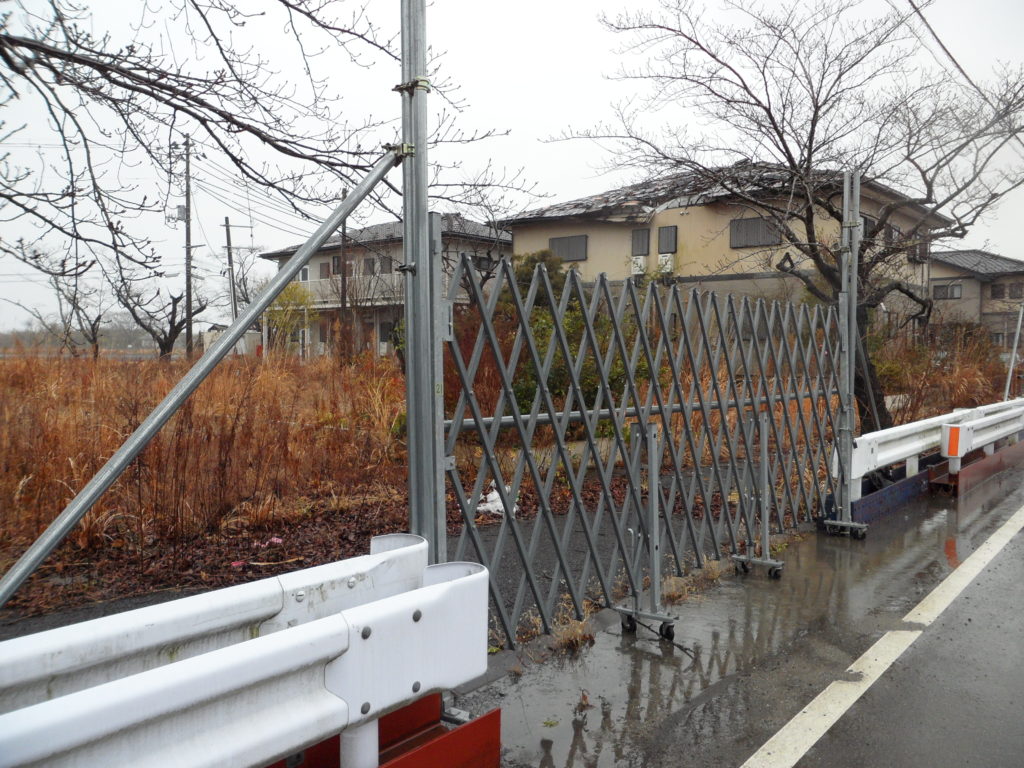
I asked our tour guide Yuki if his company had received any negative reviews or feedback about the tour being insensitive. He told us that there were many negative comments on social media about it being unsafe (because of radiation levels), but he hadn’t heard anything about the tour being disrespectful – and furthermore, he didn’t seem to understand why someone would think that. I asked several other locals similar questions, and the concept almost seemed not to translate.
Naraha
The only straight answer I got the whole time was in the town of Naraha. Our host was a young woman named Ms. Nishizaki, who is originally from Tokyo but married a man from Fukushima. She gave us a tour of their community center, which was designed with input from the whole community after the evacuation order was lifted in 2015. To date 6,784 of the 8,000-plus residents have returned.[2] The center, which opened in 2018, is called the Naraha CANvas (referencing a blank canvas for creation, the can-do attitude of the community, and even a play on the Japanese word for hall or building, pronounced kan).[3]
The CANvas is supposed to feel like a house. There is a living room area with comfy couches where community artwork is displayed. Many evacuees learned regional crafts in other parts of the country and brought those skills with them when they returned home. (I was excited to recognize a pair of fabric sandals from Aizu, the western region of Fukushima, where I used to live.) There is a kitchen where residents can cook (or teach others how to) and then sell the food from a window that opens to the sidewalk. The children’s play area is open to the rest of the space – by request of elderly residents who said it gives them hope to hear children playing.
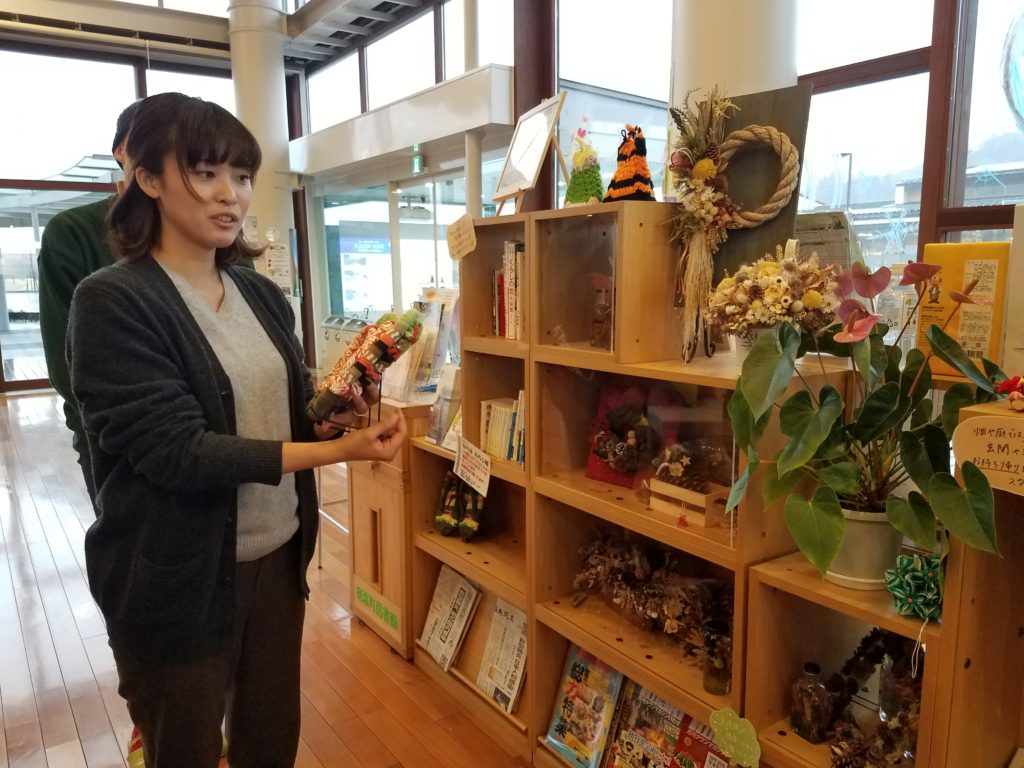
Sustainability is important to the community: from social equity, to environmental conservation, to clean energy generation. The building was constructed using as much reclaimed material as possible from old buildings that were destroyed (all materials were tested for contamination, of course). Outside are wind turbines and solar panels so artistically-constructed that it is easy to miss what they are – I did at first.
Before we left, I asked Nishizaki-san her perspective on tourists coming to see the towns that had been destroyed. She thought about it and replied that at first, residents might feel bad if people came to look right after the accident, but since it has been so long and the towns are rebuilding, residents now want visitors to come and see the fruits of their efforts.
Tomioka
Further north along the coast and closer to Daiichi, Tomioka stood entirely empty for six years, with the evacuation order partially lifted in 2017. Part of the town is still in the No-Go Zone, but the township has authority on where to prioritize cleanup efforts. The population, originally over 16,000, is currently at 12,645.[4] Local resident Ms. Aoki, who joined us on our bus for a tour of the town, explained that most of that number represents cleanup workers, and only 1,109 original residents have returned.
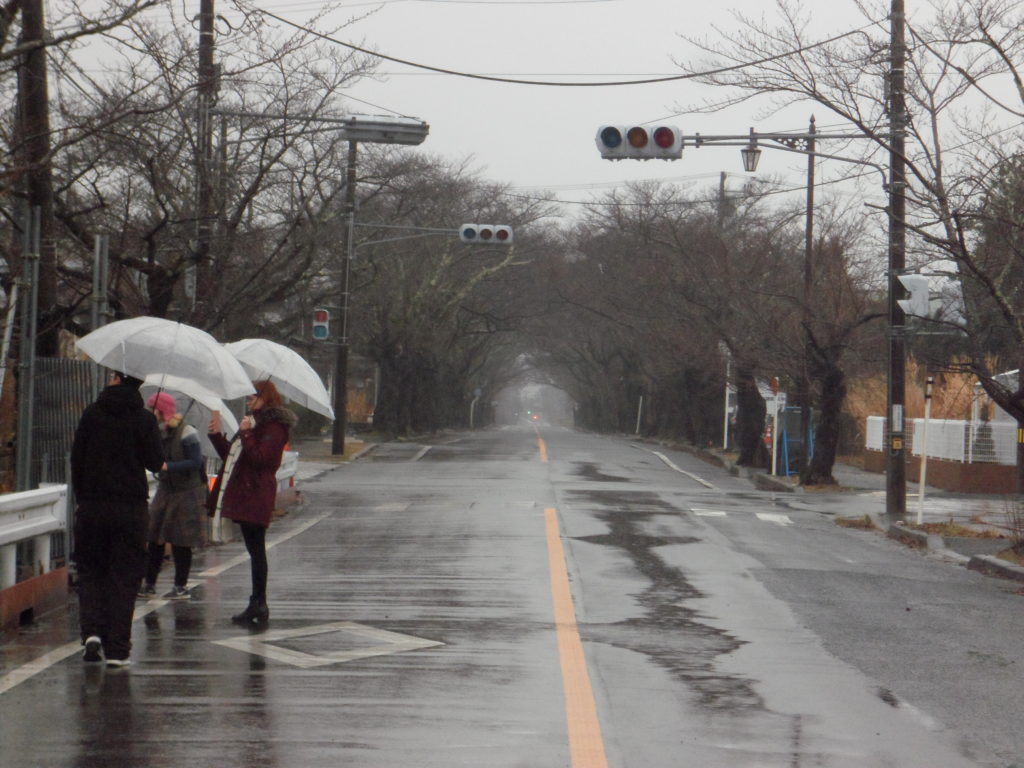
We saw their famous cherry blossom tunnel, though not at ideal viewing time. Sadly, some of the trees became sick after no care for six years and were lost. Walking down the street was a little surreal, under rainy skies and blossom-less cherry trees, seeing occupied houses to one side and abandoned ones to the other, while only a metal barricade separated us from a contaminated area where no one has lived in nine years.
Our group stopped for lunch at the grocery store food court, and Aoki-san called our attention to the fact that there were no housewives with children there, but rather cleanup workers in uniform. The whole economy of the area has shifted. Whereas previously many people worked in fishing and agriculture, now locals will work in cleanup and related services for the next several decades.
Their beautiful community center contains gathering spaces and a library, called “the forest of learning.” It was built in 2005 and served as an emergency center during the earthquake. Today, in addition to hosting community meetings, it houses a visual archive project designed to capture images of the town. The virtual reality headset wasn’t working properly the day we were there, but the idea is that one can walk through different parts of Tomioka, such as the cherry blossom tunnel in full bloom. Digital archive projects, mostly focusing on photographs and interviews, are taking place in other towns too.[5] This archive center is scheduled to open in 2021.
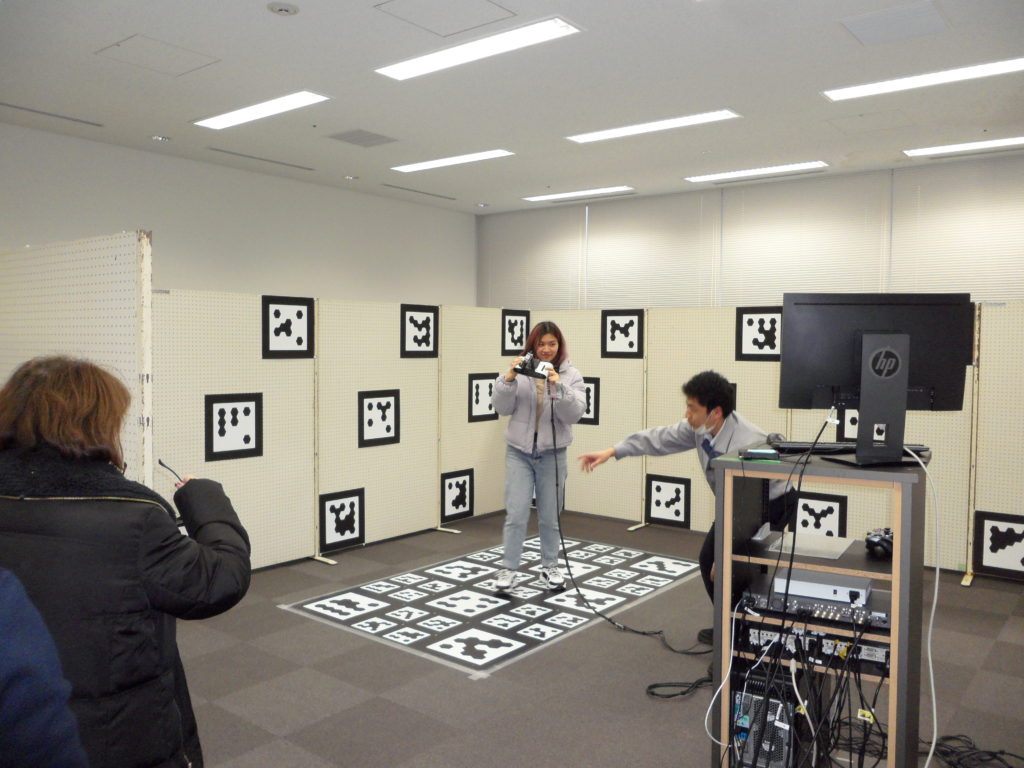
Aoki-san told us that slowly but surely, the town is coming back. It looks different, but children are returning, and it is the duty of their parents to make sure they have a future. She reminded us that there are still farmers and fishermen working hard in the area, and that all food is tested, so it is actually the safest in the country. Her parting wishes for us were enjoy the locally-caught fish and toast with the locally-made wine.
Namie
On day two, we had no official host join us in Namie, the largest of the towns we visited (originally over 17,000). However, this town, which sits north of Daiichi, really spoke for itself with some of the most striking imagery we saw on the trip.
One of the most iconic sights in Namie is Ukedo elementary school, which stands 200 meters from the shore and was the only structure in the surrounding area to have survived the disaster. The tsunami warning that went out three minutes after the earthquake was grossly underestimated at 3-6 meters (the sea wall along the beach was 7 meters high).
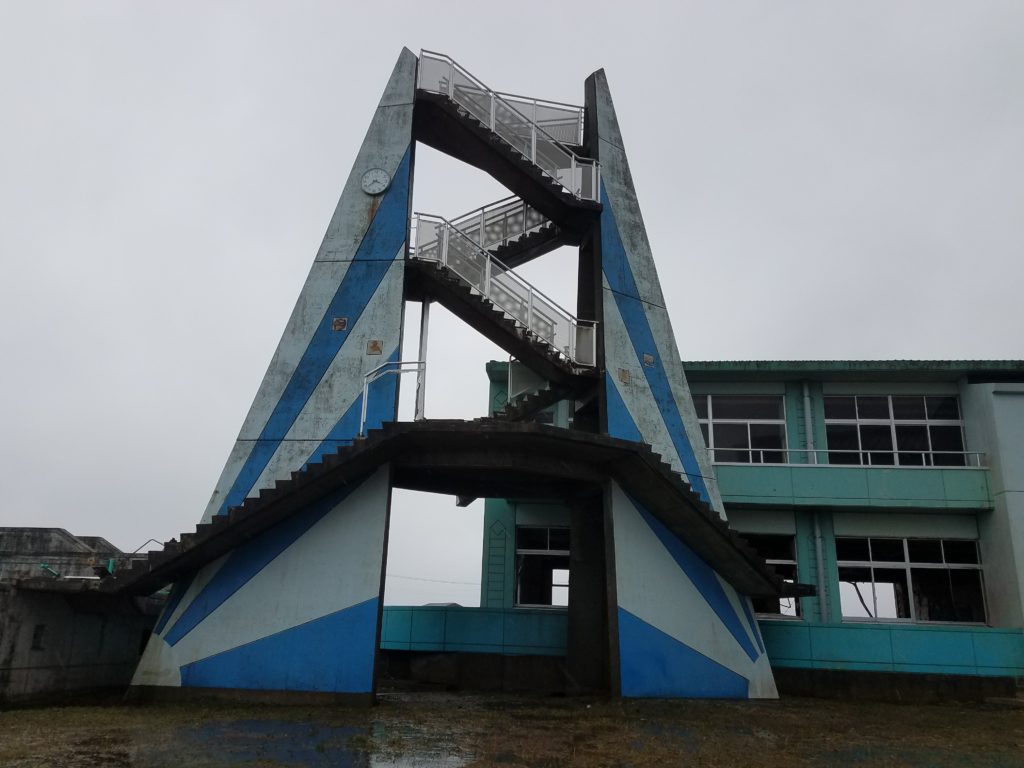
Following standard earthquake protocol, students and teachers evacuated to the courtyard to wait for further instructions, but the children thought it would be safer on high ground and ran for a hill over a mile to the west. Forty-five minutes after the earthquake, the warning was revised to 10 meters, and 7 minutes later, the 15-meter wave hit the school. Every single student survived.
The school’s clock is eerily stopped at 3:38, the time of the wave, and a high water mark remains on the top floor windows. The town is discussing plans to make it a community center, but residents are divided, seeing it as either a symbol of hope or a reminder of tragedy.
Namie has been working steadily to clear debris from the disaster, but buildings that have not been maintained in years are starting to come down on their own. However, scattered through the town are repaired homes and businesses providing necessary services, such as mail and meals, to support the 1,238 residents who have returned.[6] Even the train line is planning to reopen three stations that have been closed for years.
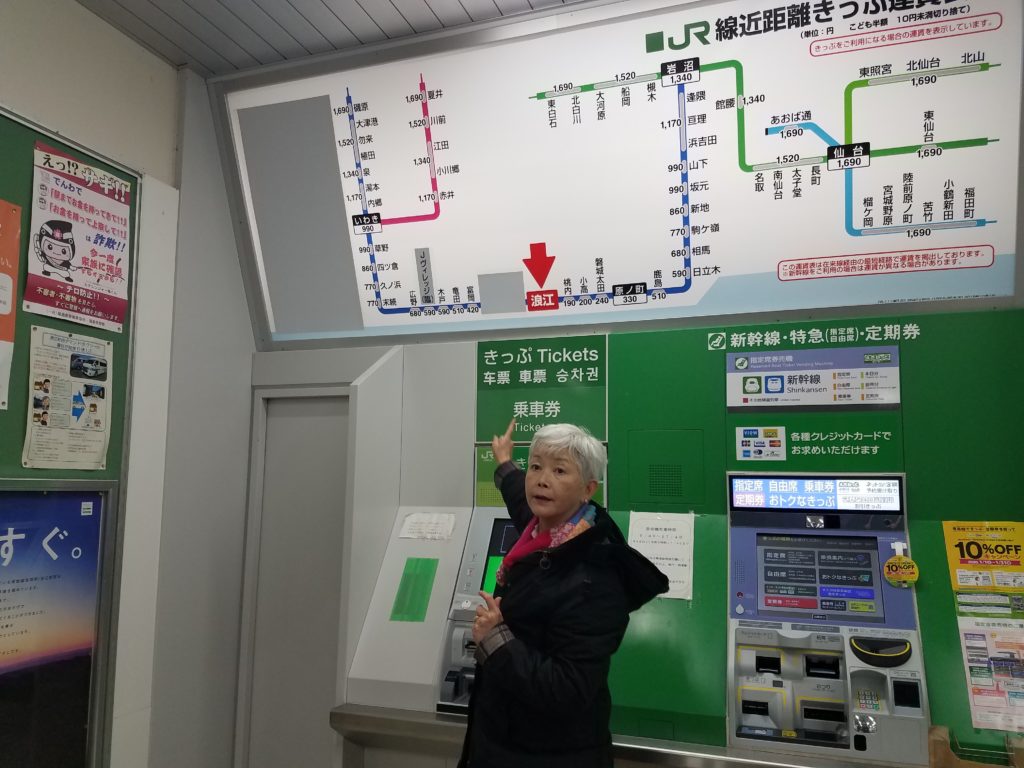
At lunch we went into a restaurant that served a local style of fried noodles. The owners were incredibly friendly and excited to talk to us about where we were from and what we were doing. I got the impression that not many visitors come through for Exclusion Zone tours – they knew what it was, but it didn’t seem like a common occurrence. They gave us plenty of suggestions for activities and sightseeing in the area, as if they wanted us to know that there were positive, beautiful reasons to come to Fukushima. They invited us back for dinner, but we explained that we were headed back to Tokyo. They were sad we couldn’t stay, but poured us a round of sake to celebrate our visit.
Economic recovery is happening slowly in Fukushima, but it is happening. Next week we will look at some of the industries that have taken the hardest hits and some that show the most promise for growth in the wake of the disaster.
Thank you for reading.
[1] https://.japanwondertravel.com
[2] https://en.wikipedia.org/wiki/Naraha,_Fukushima
[3] https://matcha-jp.com/en/place/ChIJ0SvdGcPhIGARR4Fv4oVTbME
[4] https://en.wikipedia.org/wiki/Tomioka,_Fukushima
[5] https://researchoutreach.org/articles/virtual-reality-helping-rebuild-community-devastated-fukushima-disaster/
[6] https://en.wikipedia.org/wiki/Namie,_Fukushima
2 Comments
Passport Overused · April 5, 2020 at 10:04 am
Great post 😁
Alison · April 26, 2020 at 11:20 am
Thanks!